FLORIN WEBSITE A WEBSITE ON FLORENCE © JULIA BOLTON HOLLOWAY, AUREO ANELLO ASSOCIAZIONE, 1997-2024: ACADEMIA BESSARION || MEDIEVAL: BRUNETTO LATINO, DANTE ALIGHIERI, SWEET NEW STYLE: BRUNETTO LATINO, DANTE ALIGHIERI, & GEOFFREY CHAUCER || VICTORIAN: WHITE SILENCE: FLORENCE'S 'ENGLISH' CEMETERY || ELIZABETH BARRETT BROWNING || WALTER SAVAGE LANDOR || FRANCES TROLLOPE || ABOLITION OF SLAVERY || FLORENCE IN SEPIA || CITY AND BOOK CONFERENCE PROCEEDINGS I, II, III, IV, V, VI, VII, VIII, IX, X || MEDIATHECA 'FIORETTA MAZZEI' || EDITRICE AUREO ANELLO CATALOGUE || UMILTA WEBSITE || LINGUE/LANGUAGES: ITALIANO, ENGLISH || VITA
JOHN RUSKIN
MORNINGS IN FLORENCE IV
FOURTH MORNING
THE VAULTED BOOK
[Duomo, Santa Maria Novella, Spanish
Chapel]
S early as may be
this morning, let us look for a minute or two into the
cathedral:—I was going to say, entering by one of the side
doors of the aisles;—but we can't do anything else, which
perhaps might not strike you unless you were thinking
specially of it. There are no transept doors; and one never
wanders round to the desolate front. From either of the side
doors, a few paces will bring you to the middle of the nave,
and to the point opposite the middle of the third arch from
the west end; where you will find yourself—if well in the
mid-wave—standing on a circular slab of green porphyry, which
marks the former place of the grave of the bishop Zenobius.
The larger inscription, on the wide circle of the floor
outside of you, records the translation of his body; the
smaller one round the stone at your feet—"quiescimus, domum
hanc quum adimus ultimam"—is a painful truth, I suppose, to
travellers like us, who never rest anywhere now, if we can
help it.
69. Resting here, at any
rate, for a few minutes, look up to the whitewashed vaulting
of the compartment of the roof next the west end.
You will see nothing
whatever in it worth looking at. Nevertheless, look a little
longer.
But the longer you look,
the less you will understand why I tell you to look. It is
nothing but a whitewashed ceiling: vaulted indeed,—but so is
many a tailor's garret window, for that matter. Indeed, now
that you have looked steadily for a minute or so, and are used
to the form of the arch, it seems to become so small that you
can almost fancy it the ceiling of a good-sized lumber-room in
an attic.
Having attained to this
modest conception of it, carry your eyes back to the similar
vault of the second compartment, nearer you. Very little
further contemplation will reduce that also to the similitude
of a moderately-sized attic. And then, resolving to bear, if
possible—for it is worth while,—the cramp in your neck for
another quarter of a minute, look right up to the third vault,
over your head; which, if not, in the said quarter of a
minute, reducible in imagination to a tailor's garret, will at
least sink, like the two others, into the semblance of a
common arched ceiling, of no serious magnitude or majesty.
70. Then, glance quickly
down from it to the floor, and round at the space, (included
between the four pillars), which that vault covers. It is
sixty feet square,1 four hundred square
yards of pavement,—and I believe you will have to look up
again more than once or twice, before you can convince
yourself that the mean-looking roof is swept indeed over all
that twelfth part of an acre. And still less, if I mistake
not, will you, without slow proof, believe, when you turn
yourself round towards the east end, that the narrow niche (it
really looks scarcely more than a niche) which occupies,
beyond the dome, the position of our northern choirs, is
indeed the unnarrowed elongation of the nave, whose breadth
extends round you like a frozen lake. From which experiments
and comparisons, your conclusion, I think, will be, and I am
sure it ought to be, that the most studious ingenuity could
not produce a design for the interior of a building which
should more completely hide its extent, and throw away every
common advantage of its magnitude, than this of the Duomo of
Florence.
Having arrived at this,
I assure you, quite securely tenable conclusion, we will quit
the cathedral by the western door, for once, and as quickly as
we can walk, return to the Green cloister of Sta. Maria
Novella; and place ourselves on the south side of it, so as to
see as much as we can of the entrance, on the opposite side,
to the so-called 'Spanish Chapel.'
There is, indeed, within
the opposite cloister, an arch of entrance, plain enough. But
no chapel, whatever, externally manifesting itself as worth
entering. No walls, or gable, or dome, raised above the rest
of the outbuildings—only two windows with traceries opening
into the cloister; and one story of inconspicuous building
above. You can't conceive there should be any effect of magnitude
produced in the interior, however it has been vaulted or
decorated. It may be pretty, but it cannot possibly look
large.
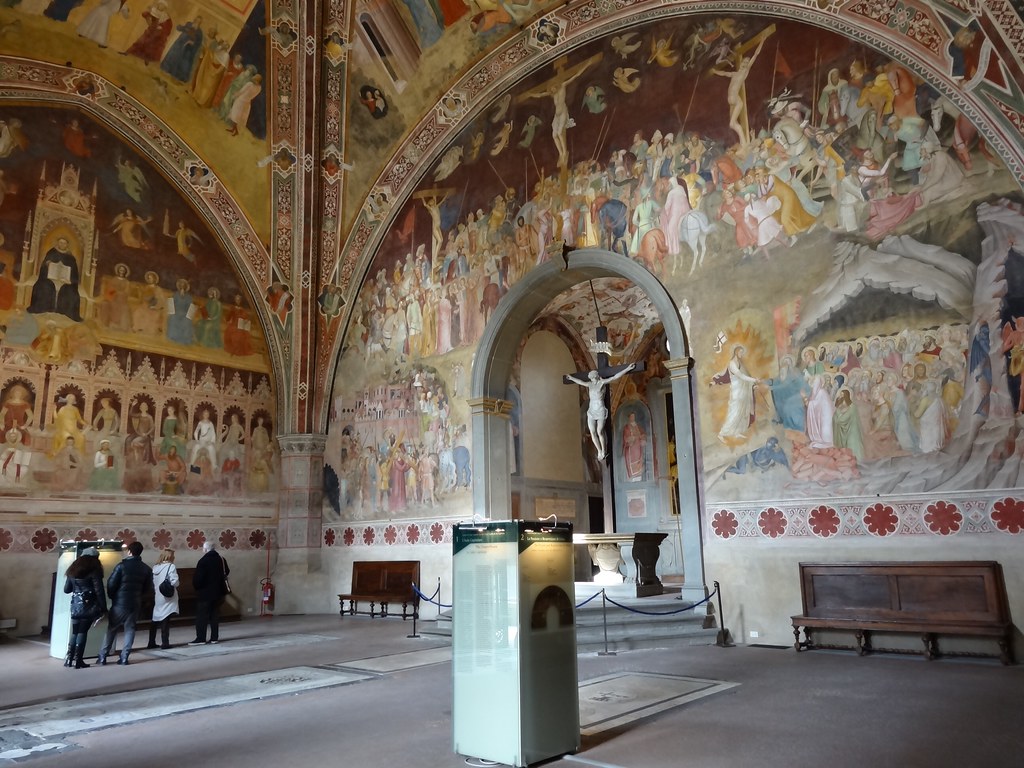
71. Entering it,
nevertheless, you will be surprised at the effect of height,
and disposed to fancy that the circular window cannot surely
be the same you saw outside, looking so low, I had to go out
again, myself, to make sure that it was.
And gradually, as you
let the eye follow the sweep of the vaulting arches, from the
small central keystone-boss, with the Lamp carved on it, to
the broad capitals of the hexagonal pillars at the
angles,—there will form itself in your mind, I think, some
impression not only of vastness in the building, but of great
daring in the builder; and at last, after closely following
out the lines of a fresco or two, and looking up and up again
to the coloured vaults, it will become to you literally one of
the grandest places you ever entered, roofed without a central
pillar. You will begin to wonder that human daring ever
achieved anything so magnificent.
But just go out again
into the cloister, and recover knowledge of the facts. It is
nothing like so large as the blank arch which at home we
filled with brickbats or leased for a gin-shop under the last
railway we made to carry coals to Newcastle. And if you pace
the floor it covers, you will find it is three feet less one
way, and thirty feet less the other, than that single square
of the Cathedral which was roofed like a tailor's
loft,—accurately, for I did measure here, myself, the floor of
the Spanish chapel is fifty-seven feet by thirty-two.
72. I hope, after this
experience, that you will need no farther conviction of the
first law of noble building, that grandeur depends on
proportion and design—not, except in a quite secondary degree,
on magnitude. Mere size has, indeed, under all disadvantage,
some definite value; and so has mere splendour. Disappointed
as you may be, or at least ought to be, at first, by St.
Peter's, in the end you will feel its size,—and its
brightness. These are all you can feel in it—it is
nothing more than the pump-room at Leamington built
bigger;—but the bigness tells at last: and Corinthian pillars
whose capitals alone are ten feet high, and their acanthus
leaves, three feet six long, give you a serious conviction of
the infallibility of the Pope, and the fallibility of the
wretched Corinthians, who invented the style indeed, but built
with capitals no bigger than hand-baskets.
Vastness has
thus its value. But the glory of architecture is to
be—whatever you wish it to be,—lovely, or grand, or
comfortable,—on such terms as it can easily obtain. Grand, by
proportion—lovely, by imagination—comfortable, by
ingenuity—secure, by honesty: with such materials and in such
space as you have got to give it.
Grand—by proportion, I
said; but ought to have said by disproportion. Beauty
is given by the relation of parts—size, by their comparison.
The first secret in getting the impression of size in this
chapel is the disproportion between pillar and arch.
You take the pillar for granted,—it is thick, strong, and
fairly high above your head. You look to the vault springing
from it—and it soars away, nobody knows where.
73. Another great, but
more subtle secret is in the inequality and
immeasurability of the curved lines; and the hiding of the
form by the colour.
To begin, the room, I
said, is fifty-seven feet wide, and only thirty-two deep. It
is thus nearly one-third larger in the direction across the
line of entrance, which gives to every arch, pointed and
round, throughout the roof, a different spring from its
neighbours.
The vaulting ribs have
the simplest of all profiles—that of a chamfered beam. I call
it simpler than even that of a square beam; for in barking a
log you cheaply get your chamfer, and nobody cares whether the
level is alike on each side: but you must take a larger tree,
and use much more work to get a square. And it is the same
with stone.
And this profile is—fix
the conditions of it, therefore, in your mind,—venerable in
the history of mankind as the origin of all Gothic
tracery-mouldings; venerable in the history of the Christian
Church as that of the roof ribs, both of the lower church of
Assisi, bearing the scroll of the precepts of St. Francis, and
here at Florence, bearing the scroll of the faith of St.
Dominic. If you cut it out in paper, and cut the corners off
farther and farther, at every cut, you will produce a sharper
profile of rib, connected in architectural use with
differently treated styles. But the entirely venerable form is
the massive one in which the angle of the beam is merely, as
it were, secured and completed in stability by removing its
too sharp edge.
74. Well, the vaulting
ribs, as in Giotto's vault, then, have here, under their
painting, this rude profile: but do not suppose the vaults are
simply the shells cast over them. Look how the ornamental
borders fall on the capitals! The plaster receives all sorts
of indescribably accommodating shapes—the painter contracting
and stopping his design upon it as it happens to be
convenient. You can't measure anything; you can't exhaust; you
can't grasp,—except one simple ruling idea, which a child can
grasp, if it is interested and intelligent: namely, that the
room has four sides with four tales told upon them; and the
roof four quarters, with another four tales told on those. And
each history in the sides has its correspondent history in the
roof. Generally, in good Italian decoration, the roof
represents constant, or essential facts; the walls,
consecutive histories arising out of them, or leading up to
them. Thus here, the roof represents in front of you, in its
main quarter, the Resurrection—the cardinal fact of
Christianity; opposite (above, behind you), the Ascension; on
your left hand, the descent of the Holy Spirit; on your right,
Christ's perpetual presence with His Church, symbolized by His
appearance on the Sea of Galilee to the disciples in the
storm.

The correspondent walls
represent: under the first quarter, (the Resurrection), the
story of the Crucifixion; under the second quarter, (the
Ascension), the preaching after that departure, that Christ
will return—symbolized here in the Dominican church by the
consecration of St. Dominic; under the third quarter, (the
descent of the Holy Spirit), the disciplining power of human
virtue and wisdom; under the fourth quarter, (St. Peter's
Ship), the authority and government of the State and Church.
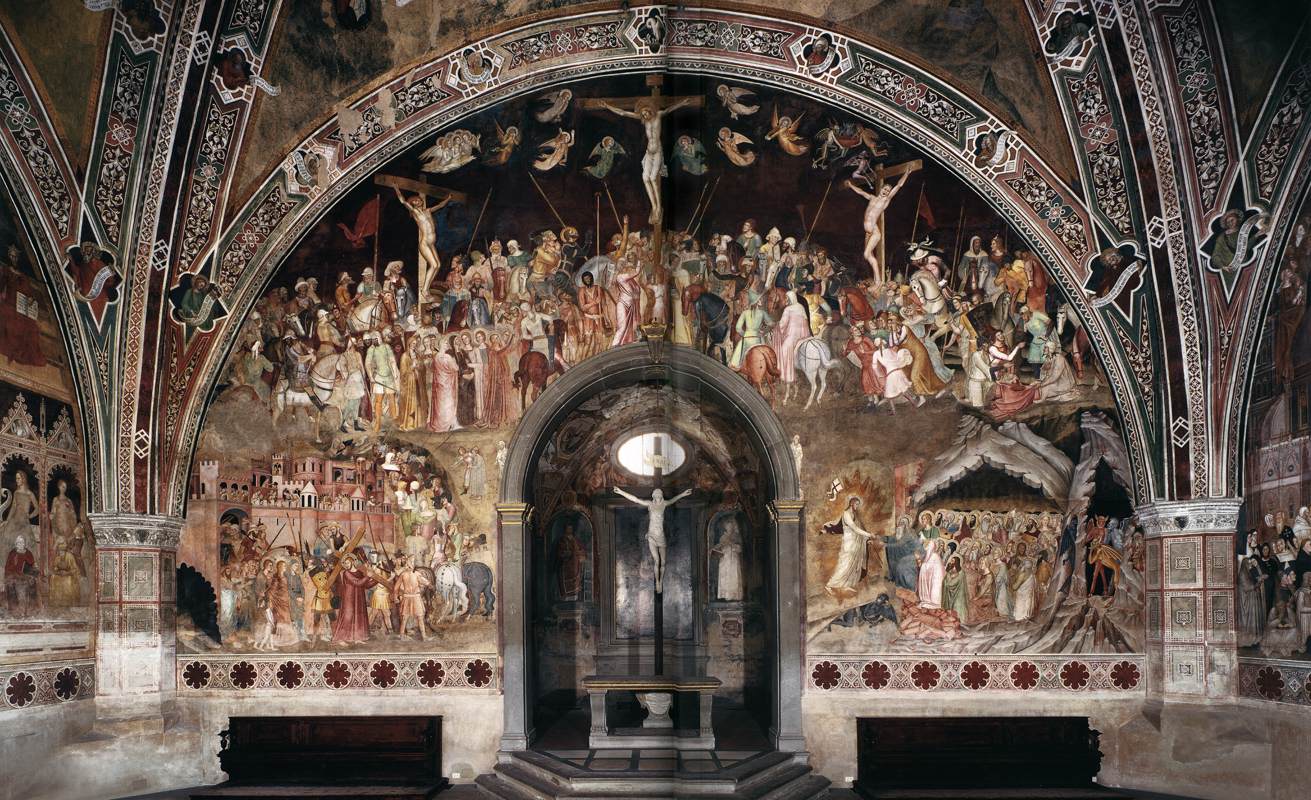
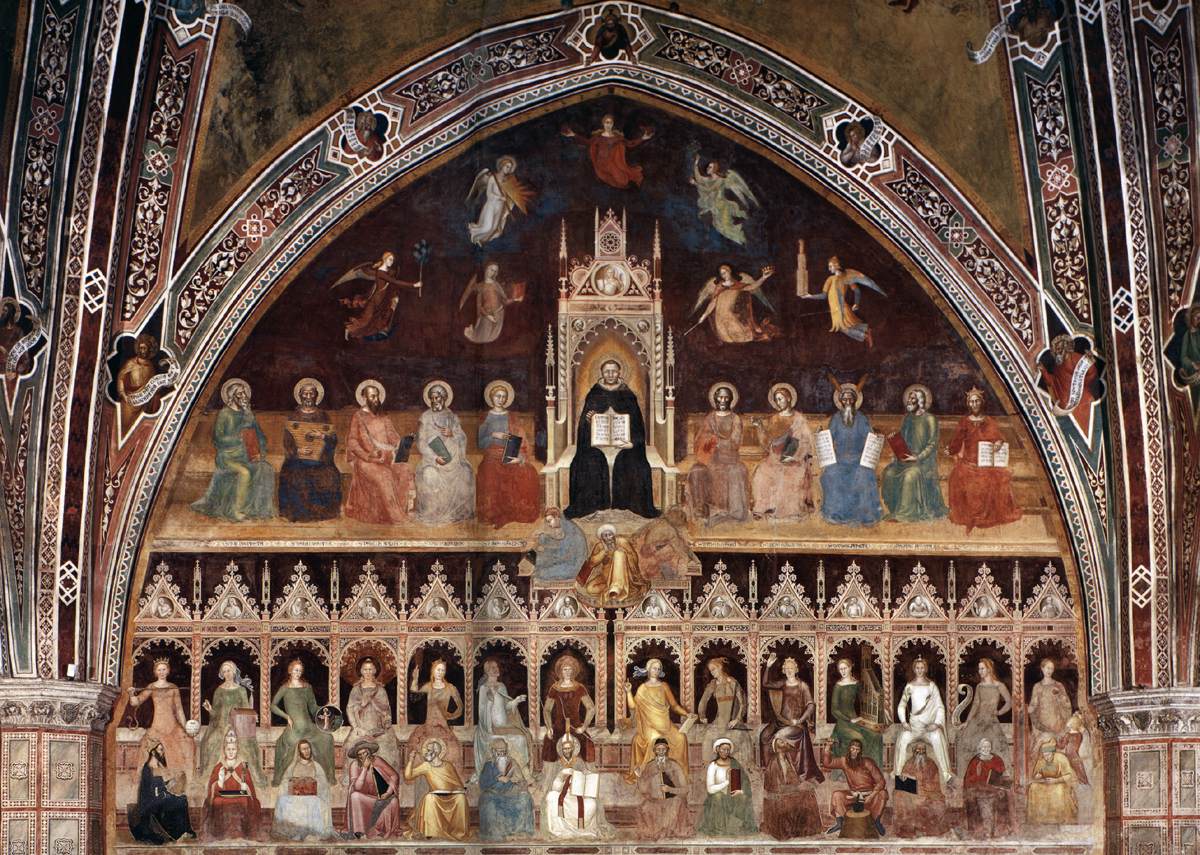
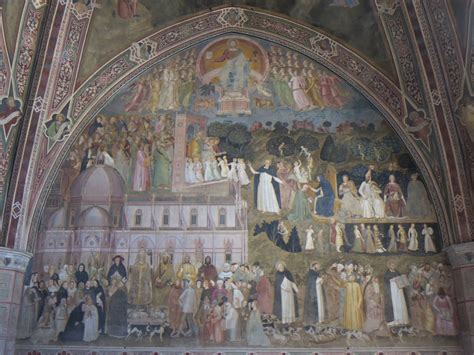
75. The order of these
subjects, chosen by the Dominican monks themselves, was
sufficiently comprehensive to leave boundless room for the
invention of the painter. The execution of it was first
intrusted to Taddeo Gaddi, the best architectural master of
Giotto's school, who painted the four quarters of the roof
entirely, but with no great brilliancy of invention, and was
beginning to go down one of the sides, when, luckily, a man of
stronger brain, his friend, came from Siena. Taddeo thankfully
yielded the room to him; he joined his own work to that of his
less able friend in an exquisitely pretty and complimentary
way; throwing his own greater strength into it, not
competitively, but gradually and helpfully. When, however, he
had once got himself well joined, and softly, to the more
simple work, he put his own force on with a will and produced
the most noble piece of pictorial philosophy2 and divinity existing
in Italy.
This pretty, and,
according to all evidence by me attainable, entirely true,
tradition has been all but lost, among the ruins of fair old
Florence, by the industry of modern mason-critics—who, without
exception, labouring under the primal (and necessarily
unconscious) disadvantage of not knowing good work from bad,
and never, therefore, knowing a man by his hand or his
thoughts, would be in any case sorrowfully at the mercy of
mistakes in a document; but are tenfold more deceived by their
own vanity, and delight in overthrowing a received idea, if
they can.
76. Farther: as every
fresco of this early date has been retouched again and again,
and often painted half over,—and as, if there has been the
least care or respect for the old work in the restorer, he
will now and then follow the old lines and match the old
colours carefully in some places, while he puts in clearly
recognizable work of his own in others,—two critics, of whom
one knows the first man's work well, and the other the last's,
will contradict each other to almost any extent on the
securest grounds. And there is then no safe refuge for an
uninitiated person but in the old tradition, which, if not
literally true, is founded assuredly on some root of fact
which you are likely to get at, if ever, through it only. So
that my general directions to all young people going to
Florence or Rome would be very short: "Know your first volume
of Vasari, and your two first books of Livy; look about you,
and don't talk, nor listen to talking."
77. On those terms, you
may know, entering this chapel, that in Michael Angelo's time,
all Florence attributed these frescos to Taddeo Gaddi and
Simon Memmi.
I have studied neither
of these artists myself with any speciality of care, and
cannot tell you positively, anything about them or their
works. But I know good work from bad, as a cobbler knows
leather, and I can tell you positively the quality of these
frescos, and their relation to contemporary panel pictures;
whether authentically ascribed to Gaddi, Memmi, or any one
else, it is for the Florentine Academy to decide.
The roof, and the north
side, down to the feet of the horizontal line of sitting
figures, were originally third-rate work of the school of
Giotto; the rest of the chapel was originally, and most of it
is still, magnificent work of the school of Siena. The roof
and north side have been heavily repainted in, many places;
the rest is faded and injured, but not destroyed in its most
essential qualities. And now, farther, you must bear with just
a little bit of tormenting history of painters.
There were two Gaddis,
father and son,—Taddeo and Angelo. And there were two Memmis,
brothers,—Simon and Philip.
78. I daresay you will
find, in the modern books, that Simon's real name was Peter,
and Philip's real name was Bartholomew; and Angelo's real name
was Taddeo, and Taddeo's real name was Angelo; and Memmi's
real name was Gaddi, and Gaddi's real name was Memmi. You may
find out all that at your leisure, afterwards, if you like.
What it is important for you to know here, in the Spanish
Chapel, is only this much that follows:—There were certainly
two persons once called Gaddi, both rather stupid in religious
matters and high art; but one of them, I don't know or care
which, a true decorative painter of the most exquisite skill,
a perfect architect, an amiable person, and a great lover of
pretty domestic life. Vasari says this was the father, Taddeo.
He built the Ponte Vecchio; and the old stones of it—which if
you ever look at anything on the Ponte Vecchio but the shops,
you may still see (above those wooden pent-houses) with the
Florentine shield—were so laid by him that they are unshaken
to this day.
He painted an exquisite
series of frescos at Assisi from the Life of Christ; in
which,—just to show you what the man's nature is,—when the
Madonna has given Christ into Simeon's arms, she can't help
holding out her own arms to him, and saying, (visibly,) "Won't
you come back to mamma?" The child laughs his answer—"I love you,
mamma; but I'm quite happy just now."
Well; he, or he and his
son together, painted these four quarters of the roof of the
Spanish Chapel. They were very probably much retouched
afterwards by Antonio Veneziano, or whomsoever Messrs. Crowe
and Cavalcasella please; but that architecture in the descent
of the Holy Ghost is by the man who painted the north transept
of Assisi, and there need be no more talk about the
matter,—for you never catch a restorer doing his old
architecture right again. And farther, the ornamentation of
the vaulting ribs is by the man who painted the
Entombment, No. 31 in the Galerie des Grands Tableaux, in the
catalogue of the Academy for 1874. Whether that picture is
Taddeo Gaddi's or not, as stated in the catalogue, I do not
know; but I know the vaulting ribs of the Spanish Chapel are
painted by the same hand.
79. Again: of the two
brothers Memmi, one or other, I don't know or care which, had
an ugly way of turning the eyes of his figures up and their
mouths down; of which you may see an entirely disgusting
example in the four saints attributed to Filippo Memmi on the
cross wall of the north (called always in Murray's guide the
south, because he didn't notice the way the church was built)
transept of Assisi. You may, however, also see the way the
mouth goes down in the much repainted, but still
characteristic No. 9 in the Uffizi.3
Now I catch the wring
and verjuice of this brother again and again, among the minor
heads of the lower frescoes in this Spanish Chapel. The head
of the Queen beneath Noah, in the Limbo,—(see below) is
unmistakable.
80. Farther: one of the
two brothers, I don't care which, had a way of painting
leaves; of which you may see a notable example in the rod in
the hand of Gabriel in that same picture of the Annunciation
in the Uffizii. No Florentine painter, or any other, ever
painted leaves as well as that, till you get down to Sandro
Botticelli, who did them much better. But the man who painted
that rod in the hand of Gabriel, painted the rod in the right
hand of Logic in the Spanish Chapel,—and nobody else in
Florence, or the world, could.
Farther (and this is the
last of the antiquarian business); you see that the frescoes
on the roof are, on the whole, dark with much blue and red in
them, the white spaces coming out strongly. This is the
characteristic colouring of the partially defunct school of
Giotto, becoming merely decorative, and passing into a
colourist school which connected itself afterwards with the
Venetians. There is an exquisite example of all its
specialities in the little Annunciation in the Uffizii, No.
14, attributed to Angelo Gaddi, in which you see the Madonna
is stupid, and the angel stupid, but the colour of the whole,
as a piece of painted glass, lovely; and the execution
exquisite,—at once a painter's and jeweller's; with subtle
sense of chiaroscuro underneath; (note the delicate shadow of
the Madonna's arm across her breast).
The head of this school
was (according to Vasari) Taddeo Gaddi; and henceforward,
without further discussion, I shall speak of him as the
painter of the roof of the Spanish Chapel,—not without
suspicion, however, that his son Angelo may hereafter turn out
to have been the better decorator, and the painter of the
frescoes from the life of Christ in the north transept of
Assisi,—with such assistance as his son or scholars might
give—and such change or destruction as time, Antonio
Veneziano, or the last operations of the Tuscan railroad
company, may have effected on them.
81. On the other hand,
you see that the frescos on the walls are of paler colours,
the blacks coming out of these clearly, rather than the
whites; but the pale colours, especially, for instance, the
whole of the Duomo of Florence in that on your right, very
tender and lovely. Also, you may feel a tendency to express
much with outline, and draw, more than paint, in the most
interesting parts; while in the duller ones, nasty green and
yellow tones come out, which prevent the effect of the whole
from being very pleasant. These characteristics belong, on the
whole, to the school of Siena; and they indicate here the work
assuredly of a man of vast power and most refined
education, whom I shall call without further discussion,
during the rest of this and the following morning's study,
Simon Memmi.
82. And of the grace and
subtlety with which he joined his work to that of the Gaddis,
you may judge at once by comparing the Christ standing on the
fallen gate of the Limbo, with the Christ in the Resurrection
above. Memmi has retained the dress and imitated the general
effect of the figure in the roof so faithfully that you
suspect no difference of mastership—nay, he has even raised
the foot in the same awkward way: but you will find Memmi's
foot delicately drawn-Taddeo's, hard and rude: and all the
folds of Memmi's drapery cast with unbroken grace and complete
gradations of shade, while Taddeo's are rigid and meagre; also
in the heads, generally Taddeo's type of face is square in
feature, with massive and inelegant clusters or volutes of
hair and beard; but Memmi's delicate and long in feature, with
much divided and flowing hair, often arranged with exquisite
precision, as in the finest Greek coins. Examine successively
in this respect only the heads of Adam, Abel, Methuselah, and
Abraham, in the Limbo, and you will not confuse the two
designers any more. I have not had time to make out more than
the principal figures in the Limbo, of which indeed the entire
dramatic power is centred in the Adam and Eve. The latter
dressed as a nun, in her fixed gaze on Christ, with her hands
clasped, is of extreme beauty: and however feeble the work of
any early painter may be, in its decent and grave
inoffensiveness it guides the imagination unerringly to a
certain point. How far you are yourself capable of filling up
what is left untold and conceiving, as a reality, Eve's first
look on this her child, depends on no painter's skill, but on
your own understanding. Just above Eve is Abel, bearing the
lamb: and behind him, Noah, between his wife and Shem: behind
them, Abraham, between Isaac and Ishmael; (turning from
Ishmael to Isaac), behind these, Moses, between Aaron and
David. I have not identified the others, though I find the
white-bearded figure behind Eve called Methuselah in my notes:
I know not on what authority. Looking up from these groups,
however, to the roof painting, you will at once feel the
imperfect grouping and ruder features of all the figures; and
the greater depth of colour. We will dismiss these
comparatively inferior paintings at once.
83. The roof and walls
must be read together, each segment of the roof forming an
introduction to, or portion of, the subject on the wall below.
But the roof must first be looked at alone, as the work of
Taddeo Gaddi, for the artistic qualities and failures of it.
I. In front, as you
enter, is the compartment with the subject of the
Resurrection. It is the traditional Byzantine composition: the
guards sleeping, and the two angels in white saying to the
women, "He is not here," while Christ is seen rising with the
flag of the Cross.
But it would be
difficult to find another example of the subject, so coldly
treated—so entirely without passion or action. The faces are
expressionless; the gestures powerless. Evidently the painter
is not making the slightest effort to conceive what really
happened, but merely repeating and spoiling what he could
remember of old design, or himself supply of commonplace for
immediate need. The "Noli me tangere," on the right, is
spoiled from Giotto, and others before him; a peacock,
woefully plumeless and colourless, a fountain, an ill drawn
toy-horse, and two toy-children gathering flowers, are
emaciate remains of Greek symbols. He has taken pains with the
vegetation, but in vain. Yet Taddeo Gaddi was a true painter,
a very beautiful designer, and a very amiable person. How
comes he to do that Resurrection so badly?
In the first place, he
was probably tired of a subject which was a great strain to
his feeble imagination; and gave it up as impossible: doing
simply the required figures in the required positions. In the
second, he was probably at the time despondent and feeble
because of his master's death. See Lord Lindsay, II. 273,
where also it is pointed out that in the effect of the light
proceeding from the figure of Christ, Taddeo Gaddi indeed was
the first of the Giottisti who showed true sense of light and
shade. But until Lionardo's time the innovation did not
materially affect Florentine art.
84. II. The Ascension
(opposite the Resurrection, and not worth looking at, except
for the sake of making more sure our conclusions from the
first fresco). The Madonna is fixed in Byzantine stiffness,
without Byzantine dignity.
III. The Descent of the
Holy Ghost, on the left hand. The Madonna and disciples are
gathered in an upper chamber: underneath are the Parthians,
Medes, Elamites, etc., who hear them speak in their own
tongues.
Three dogs are in the
foreground—their mythic purpose the same as that of the two
verses which affirm the fellowship of the dog in the journey
and return of Tobias: namely, to mark the share of the lower
animals in the gentleness given by the outpouring of the
Spirit of Christ.
IV. The Church sailing
on the Sea of the World. St. Peter coming to Christ on the
water.
I was too little
interested in the vague symbolism of this fresco to examine it
with care—the rather that the subject beneath, the literal
contest of the Church with the world, needed more time for
study in itself alone than I had for all Florence.
85. On this, and the
opposite side of the chapel, are represented, by Simon Memmi's
hand, the teaching power of the Spirit of God, and the saving
power of the Christ of God, in the world, according to the
understanding of Florence in his time.
We will take the side of
Intellect first, beneath the pouring forth of the Holy Spirit.
In the point of the arch
beneath, are the three Evangelical Virtues. Without these,
says Florence, you can have no science. Without Love, Faith,
and Hope—no intelligence.
Under these are the four
Cardinal Virtues, the entire group being thus arranged:—
A
B
C
D E F G
A, Charity; flames
issuing from her head and hands.
B, Faith; holds cross and shield, quenching fiery darts.
This symbol, so frequent in modern adaptation from St. Paul's
address to
personal faith, is rare in older art.
C, Hope, with a branch of lilies.
D, Temperance; bridles a black fish, on which she stands.
E, Prudence, with a book.
F, Justice, with crown and baton.
G, Fortitude, with tower and sword.
Under these are the
great prophets and apostles; on the left,[4] David, St. Paul, St.
Mark, St. John; on the right, St. Matthew, St. Luke, Moses,
Isaiah, Solomon. In the midst of the Evangelists, St. Thomas
Aquinas, seated on a Gothic throne.
86. Now observe, this
throne, with all the canopies below it, and the complete
representation of the Duomo of Florence opposite, are of
finished Gothic of Orcagna's school—later than Giotto's
Gothic. But the building in which the apostles are gathered at
the Pentecost is of the early Romanesque mosaic school, with a
wheel window from the duomo of Assisi, and square windows from
the Baptistery of Florence. And this is always the type of
architecture used by Taddeo Gaddi: while the finished Gothic
could not possibly have been drawn by him, but is absolute
evidence of the later hand.
Under the line of
prophets, as powers summoned by their voices, are the mythic
figures of the seven theological or spiritual, and the seven geological
or natural sciences: and under the feet of each of them, the
figure of its Captain-teacher to the world.
I had better perhaps
give you the names of this entire series of figures from left
to right at once. You will see presently why they are numbered
in a reverse order.
Beneath
whom
8. Civil Law. The Emperor Justinian.
9. Canon Law. Pope Clement V.
10. Practical Theology. Peter Lombard.
11. Contemplative Theology. Dionysius the Areopagite.
12. Dogmatic Theology. Boethius.
13. Mystic Theology. St. John Damascene.
14. Polemic Theology. St. Augustine.
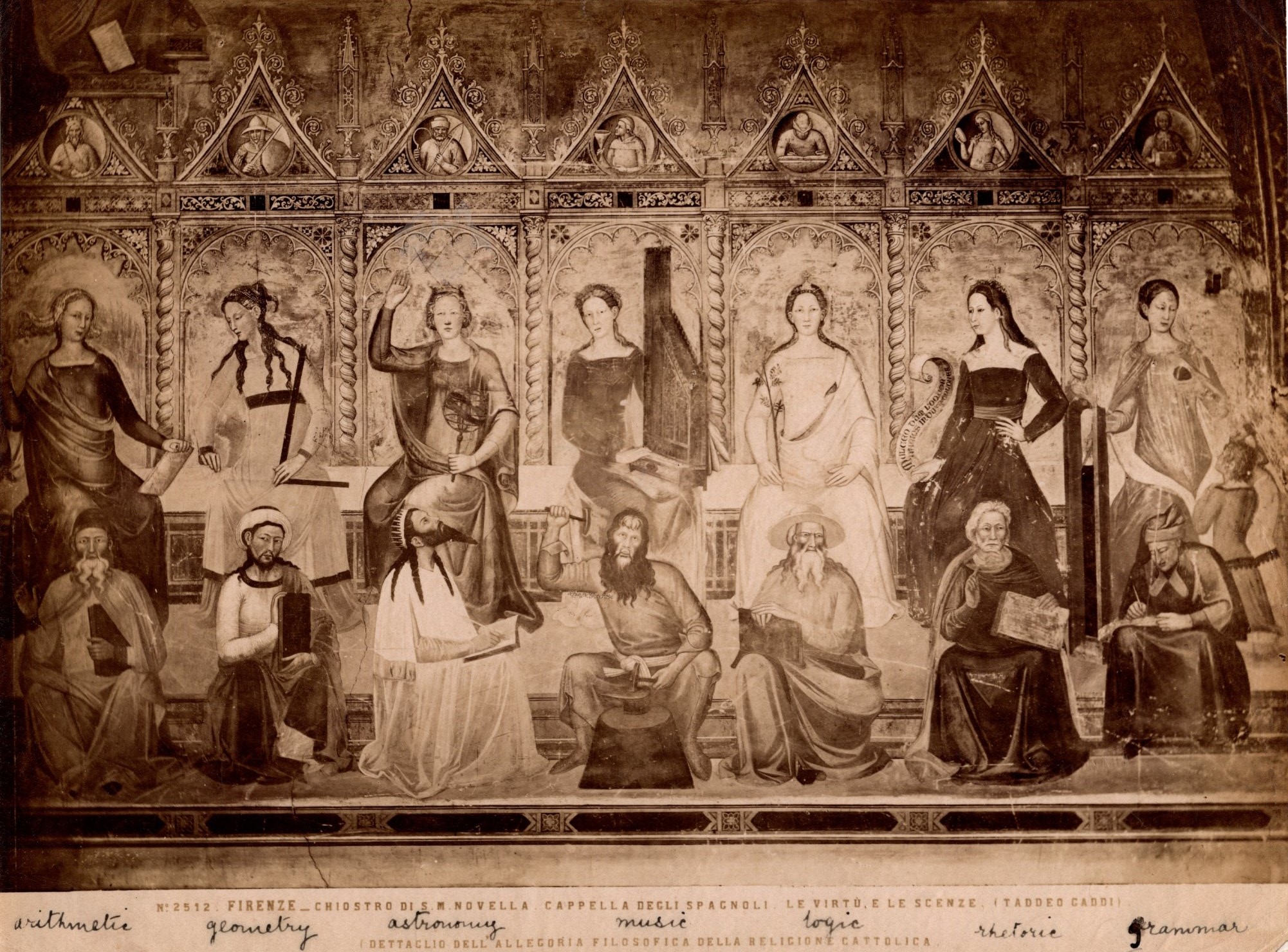
For
larger image, click here
7. Arithmetic. Pythagoras.
6. Geometry. Euclid.
5. Astronomy. Zoroaster.
4. Music. Tubalcain.
3. Logic. Aristotle.
2. Rhetoric. Cicero.
1. Grammar. Priscian.
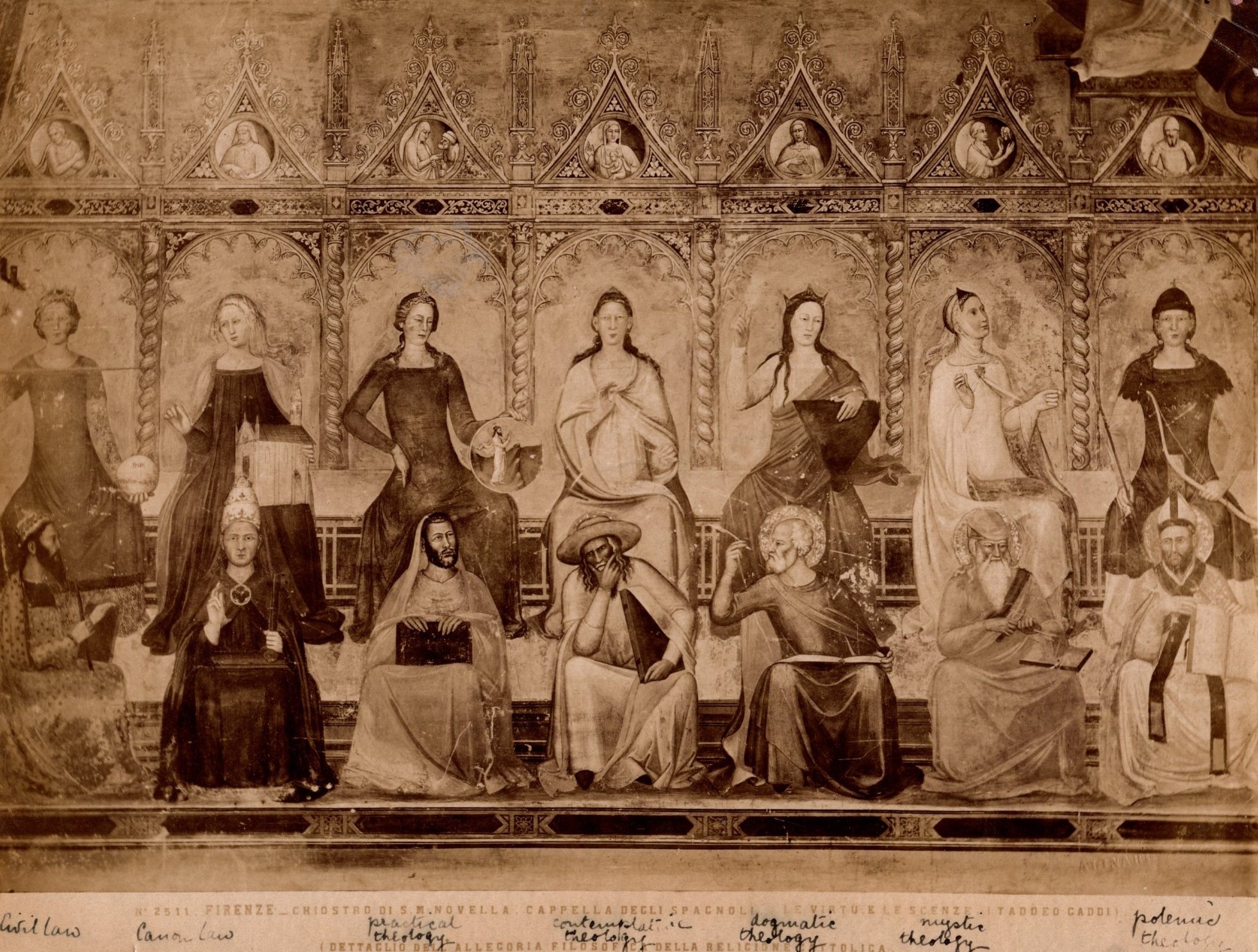
N. 2511. Firenze. Chiostro di S. M. Novella,
Capella degli Spagnoli. Le virtù e le scienze (Taddeo Gaddi).
Dettaglio dell'Allegoria filosofica della religione cattolica
Beneath the figures a Sister has written: 'Civil law,
canon law, practical theology, contemplative theology, dogmatic
theology, mystic theology, polemical theology'
For larger
image, click here
87. Here, then, you have
pictorially represented, the system of manly education,
supposed in old Florence to be that necessarily instituted in
great earthly kingdoms or republics, animated by the Spirit
shed down upon the world at Pentecost. How long do you think
it will take you, or ought to take, to see such a picture? We
were to get to work this morning, as early as might be: you
have probably allowed half an hour for Santa Maria Novella;
half an hour for San Lorenzo; an hour for the museum of
sculpture at the Bargello; an hour for shopping; and then it
will be lunch time, and you mustn't be late, because you are
to leave by the afternoon train, and must positively be in
Rome to-morrow morning. Well, of your half-hour for Santa
Maria Novella,—after Ghirlandajo's choir, Orcagna's transept,
and Cimabue's Madonna, and the painted windows, have been seen
properly, there will remain, suppose, at the utmost, a quarter
of an hour for the Spanish Chapel. That will give you two
minutes and a half for each side, two for the ceiling, and
three for studying Murray's explanations or mine. Two minutes
and a half you have got, then—(and I observed, during my five
weeks' work in the chapel, that English visitors seldom gave
so much)—to read this scheme given you by Simon Memmi of human
spiritual education. In order to understand the purport of it,
in any the smallest degree, you must summon to your memory, in
the course of these two minutes and a half, what you happen to
be acquainted with of the doctrines and characters of
Pythagoras, Zoroaster, Aristotle, Dionysius the Areopagite,
St. Augustine, and the emperor Justinian, and having further
observed the expressions and actions attributed by the painter
to these personages, judge how far he has succeeded in
reaching a true and worthy ideal of them, and how large or how
subordinate a part in his general scheme of human learning he
supposes their peculiar doctrines properly to occupy. For
myself, being, to my much sorrow, now an old person; and, to
my much pride, an old-fashioned one, I have not found my
powers either of reading or memory in the least increased by
any of Mr. Stephenson's or Mr. Wheatstone's inventions; and
though indeed I came here from Lucca in three hours instead of
a day, which it used to take, I do not think myself able, on
that account, to see any picture in Florence in less time than
it took formerly, or even obliged to hurry myself in any
investigations connected with it.
88. Accordingly, I have
myself taken five weeks to see the quarter of this picture of
Simon Memmi's: and can give you a fairly good account of that
quarter, and some partial account of a fragment or two of
those on the other walls: but, alas! only of their pictorial
qualities in either case; for I don't myself know anything
whatever, worth trusting to, about Pythagoras, or Dionysius
the Areopagite; and have not had, and never shall have,
probably, any time to learn much of them; while in the very
feeblest light only,—in what the French would express by their
excellent word 'lueur,'—I am able to understand something of
the characters of Zoroaster, Aristotle, and Justinian. But
this only increases in me the reverence with which I ought to
stand before the work of a painter, who was not only a master
of his own craft, but so profound a scholar and theologian as
to be able to conceive this scheme of picture, and write the
divine law by which Florence was to live. Which Law, written
in the northern page of this Vaulted Book, we will begin quiet
interpretation of, if you care to return hither, to-morrow
morning.
Notes
1· · Approximately.
Thinking I could find the dimensions of the Duomo anywhere, I
only paced it myself,—and cannot, at this moment, lay my hand
on English measurements of it.
2· · There
is no philosophy taught either by the school of Athens
or Michael Angelo's 'Last Judgment,' and the 'Disputa' is
merely a graceful assemblage of authorities, the effects of
such authority not being shown.
3· · This
picture
bears the inscription (I quote from the French catalogue, not
having verified it myself), "Simon Martini, et Lippus Memmi de
Senis me pinxerunt." I have no doubt whatever, myself, that
the two brothers worked together on these frescoes of the
Spanish Chapel: but that most of the Limbo is Philip's, and
the Paradise, scarcely with his interference, Simon's.
4·
I can't find my note of the first one on the left;
answering to Solomon, opposite.
GO TO FIFTH
MORNING
FLORIN WEBSITE
A WEBSITE
ON FLORENCE © JULIA BOLTON HOLLOWAY, AUREO ANELLO ASSOCIAZIONE,
1997-2024: ACADEMIA
BESSARION
||
MEDIEVAL: BRUNETTO
LATINO, DANTE
ALIGHIERI, SWEET NEW STYLE: BRUNETTO
LATINO, DANTE
ALIGHIERI, &
GEOFFREY CHAUCER
|| VICTORIAN:
WHITE
SILENCE:
FLORENCE'S
'ENGLISH'
CEMETERY
|| ELIZABETH
BARRETT BROWNING
|| WALTER
SAVAGE LANDOR
|| FRANCES
TROLLOPE
|| ABOLITION
OF SLAVERY
|| FLORENCE
IN SEPIA
|| CITY AND BOOK CONFERENCE
PROCEEDINGS
I, II, III,
IV,
V,
VI,
VII,
VIII,
IX,
X
|| MEDIATHECA
'FIORETTA
MAZZEI'
|| EDITRICE
AUREO ANELLO CATALOGUE
|| UMILTA
WEBSITE
|| LINGUE/LANGUAGES: ITALIANO,
ENGLISH
|| VITA